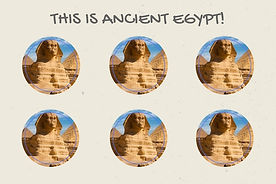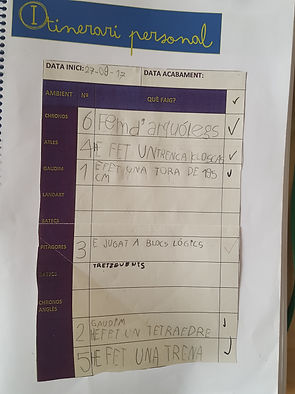
The school where I will implement my Teaching Sequence follows the methodology of working by proposals which means that students have some hours per day to freely circulate and do autonomously the proposals that they choose regarding their interests in that moment. Based on this way of learning, thus, I have adapted my teaching sequence and decided to design a series of proposals related to the topic chosen.
I am in Chronos ambient, which means that all the proposals in the classroom are related to history. They have started the school year with the topic of dinosaurs and the prehistory and they keep introducing new historical periods chronologically. By January, they will have started working on Ancient Egypt in Catalan, and that is why the theme chosen for this teaching sequence is Egypt. Chronos is a 25-student-group class consisting of 1st, 2nd and 3rd graders and this age-mixed organization is something I will bear in mind when designing and implementing the proposals. What is more, the English level of the students is not very high, as they are not used to be in contact with the language, and so they are not very familiar with it.
Taking into consideration all these facts, all of the following proposals will offer careful and precise visual and textual scaffolding with the goal of achieving everyone’s learning successfully. Also, it is important to highlight the fact that the students may have some vocabulary foundation on Egypt in Catalan and this will help them interiorize better the contents in English.
The proposals I have planned can be implemented independently, but they have as a common focus the topic of Egypt: Egypt’s basic vocabulary, the Pyramids, Egyptian mythology, the Pharaohs, the Egyptian society and the Hieroglyphics. Besides, the main area they will work on is History, while other areas such as Arts, Maths and English will also be present in some of the activities.
In order to engage the students to carry out the different proposals, I will create a “PASSPORT TO EGYPT” sheet in which they will register the activities that they do as well as their personal information. They will have to implement all Egypt proposals of the passport to be real pharaohs and get a “super Egyptian certificate!” Every time they finish one of the activities and it is revised by the teacher, they will be given a badge to stick in their passport sheet.
Travelling to Egypt!






-
Identify and name the different Ancient Egypt elements
-
Recognize the faces, edges and vertices of a Pyramid
-
Create an Egyptian amulet with diverse materials
-
Comprehend the Egyptian Society hierarchy
-
Identify and name the different Egyptian gods and goddesses
-
Decode Egyptian hieroglyphics
LEARNING OBJECTIVES
CONTENT OBJECTIVES
LANGUAGE OBJECTIVES
-
Acquire the key vocabulary of each proposal
-
Comprehend and follow instructions autonomously in English
-
Know the class materials in English
-
Apply the "It's your turn" expression when playing a game
-
Understand a video in English
Students Will Be Able To:
COMPETENCES
CONTENT
-
Social and cultural competence: this competence is present in all the teaching proposals, as the main topic worked is the Ancient Egypt, and so they will be learning how people lived in those times as well as the main characteristics of the period and the Egyptians
-
Communication in foreign language: students will develop their linguistic/communicative skills in English throughout all the proposals. All language domains will be worked, although some of them in a small basis: reading, listening, writing and speaking.
-
ICT and digital competence: they will learn how to obtain and interpret the information from some videos.
-
Artistic competence: In some proposals they will be carrying out several arts and crafts activities that will provide children with the opportunity to develop their artistic creativity.
-
Mathematical competence: This competence will be present in the pyramids proposal in which they are asked to identify the parts of a geometrical figure.
LINGUISTIC CONTENT
NON- LINGUISTIC CONTENT
Ancient Egypt vocabulary in English
"It's your turn" expression
Colours and material vocabulary in English
Verb to be in simple sentences
Ancient Egypt elements
Parts of a pyramid: faces, edges and vertices
Ancient Egypt society hierarchy
Ancient Egypt mythology
Hieroglyphics
Designing the assessment aspects has been a bit complex when planning the teaching sequence. First of all, the proposals are exposed to all students of Mitjans, that is 175 children, so I do not know who I will assess. Therefore, it will be difficult to know if all of them have achieved the objectives I established successfully. Also, the kids are not used to do exams neither summative assessment sheets that evidence and show their learning.
Teachers from the school gather learning evidences from the children thanks to the personal notebooks in which they are supposed to register all the proposals itineraries they follow throughout the school year, as well as other meaningful and extra activities. Their assessment highlights students’ interest and motivation. Based on this fact, I have decided to design autonomous assessment tasks for each activity, which they will have to complete and stick in their notebooks. Some of these tasks will focus on self-assessing their learning, such as List 5 concepts you have learnt, or Which colours/materials have I used. Anyway, in ALL proposals there will be a Traffic light evaluation in which they will self-assess how much did they understand of the proposal.
ASSESSMENT





